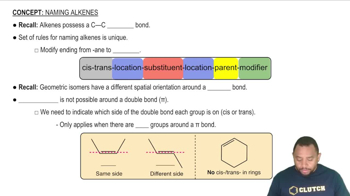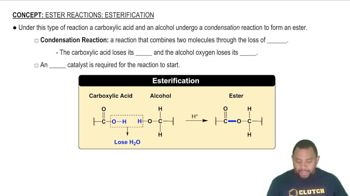Here are the essential concepts you must grasp in order to answer the question correctly.
Functional Groups
Functional groups are specific groups of atoms within molecules that are responsible for the characteristic chemical reactions of those molecules. They determine the properties and reactivity of organic compounds. Understanding functional groups is essential for predicting how different compounds will behave in chemical reactions.
Recommended video:
Carbonyl Functional Groups
Alkenes
Alkenes are hydrocarbons that contain at least one carbon-carbon double bond (C=C). This double bond is the functional group of alkenes, which influences their reactivity and physical properties. Alkenes are typically more reactive than alkanes due to the presence of this double bond, making them important in various chemical reactions, including polymerization.
Recommended video:
Alcohols, Esters, and Amines
Alcohols contain a hydroxyl group (-OH) as their functional group, which makes them polar and capable of hydrogen bonding. Esters are characterized by a carbonyl group (C=O) adjacent to an ether group (–O–), giving them unique flavors and fragrances. Amines feature a nitrogen atom bonded to one or more alkyl or aryl groups, and their functional group (-NH2, -NHR, or -NR2) influences their basicity and solubility in water.
Recommended video:
Ester Reactions: Esterification




